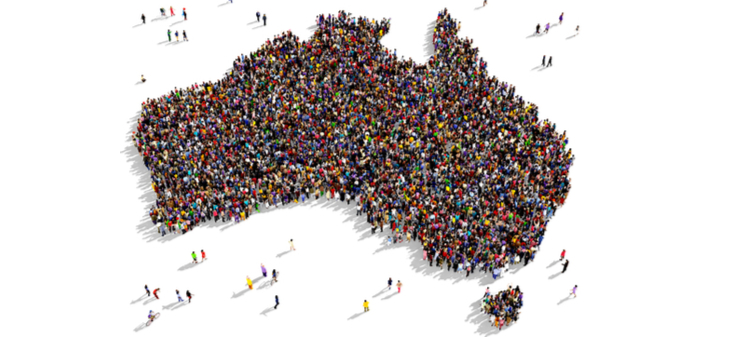Federal government plans to open the immigration floodgates have voters concerned about the damage to community, infrastructure and environment due to overpopulation.
The government’s ‘Big Australia’ push has been knocked back by 58 per cent of voters in a survey conducted by research company Resolve Strategic.
The results, published in The Age, show almost six in 10 voters want migration to resume at lower levels than before the pandemic. Only seven per cent of voters want to restart migration at a higher level than in the past. Another 20 per cent are happy with an intake of about 160,000 migrants each year.
Support for a lower migrant intake was stronger among Coalition voters, with 65 per cent in favour of a lower level compared to 58 per cent of Labor voters.
Having reopened the border to students, temporary workers and some fully vaccinated tourists, Prime Minister Scott Morrison says he will make “sensible” and “balanced” decisions to rebuild the economy through migration.
His government is keen to add around 200,000 migrants in the next month or two. Other groups estimate this number could be as high as 235,000.
“We’re expecting probably around about 200,000 or thereabouts who fit into the skilled and other visa categories that we would hope would take this up,” Mr Morrison said on Monday.
“Whether they take them all up in December or they take them up in January, well, we’ll see.”
Labor home affairs spokesperson Kristina Keneally has accused the government of encouraging temporary migration to fill jobs, which will lead to higher unemployment and wage stagnation for Australians.
“When we talk about a plan to build back better, when we talk about needing a plan for migration, we have an obligation to ensure that we have a migration program that works in the national interest, that gives Australians a first go and a fair go at jobs,” said Senator Keneally.
She wants a policy that eliminates wage theft and exploitation, invests in training and prevents employers getting skilled labour from overseas rather than spending on skills in Australia.
Read: Experts tell why migration may not be the best economic play
A separate opinion poll by The Australian Population Research Institute (TAPRI) found that 70 per cent of Australians did not wish to return to pre-COVID immigration levels of 240,000 per year.
In contrast, an Essential Research (ER) poll suggests a declining proportion of respondents were concerned about immigration levels being too high.
Sociologist and member of the Australian Sociological Association and Sustainable Population Australia (SPA), Dr Katharine Betts, attributes the difference in results to three fundamentals.
Read: What Aussies think about migration
“First, the survey questions were different. The ER was asking respondents how they felt about what had happened in the past, TAPRI was asking what they wanted for the future. In addition, the ER question provided no background information, whereas TAPRI’s question provided contextual information about past levels of immigration and recent border closures,” she says.
“Second, nearly one in five of the ER sample would have been non-voters, while all of the TAPRI sample were voters. Thus, the TAPRI results are a more accurate measure of the views of Australian voters; an important difference if policy is to be built around such information.
“Third, TAPRI weighted its survey data to accurately reflect graduate versus non-graduate educational status within the Australian population. The ER data do not appear to have been weighted for graduate/non-graduate status. This is an important difference.
“Typically, graduates are rather more likely to respond to surveys. They are also more likely to vote Labor or Greens than are non-graduates, and to have different views on topics such as immigration. TAPRI analysis has found graduates to be more likely to favour higher immigration numbers than non-graduates.”
Dr Betts suggests that for more accurate results, data should be adjusted to accurately reflect this graduate/non-graduate distinction.
SPA national president Jenny Goldie agrees with the analysis.
“There are many surveys produced and they vary considerably in methodology and quality. The public are often at a loss to know what to believe,” she says.
“Dr Betts’ careful and in-depth analysis reinforces the confidence we hold in the accuracy and integrity of the TAPRI findings.
“They correspond closely to abundant anecdotal evidence. The message? People do not want to return to the pre-pandemic trends of extreme population growth generated by high levels of immigration.”
Ms Goldie says the federal government would do well to note the sentiment of ordinary Australians.
Read: Top election issues for older Australians
“The setting of migration targets has historically been a secretive process which has been overly influenced by big business and other vested interests that benefit from the downward pressure on wages and the endless consumer market produced by enormous volumes of immigrants. But these benefits are only for a few,” she says.
“The old mantra of Big Australia does not wash any more. People are tired of the constant pressures created by incessant population growth and do not want to go back to that – especially after all the stresses of COVID-19. They want a future worth having.”
Prior to the pandemic, Australia’s population growth, at around 1.6 per cent, was among the highest in the developed world. That growth was driven largely by high levels of net migration of up to 240,000 people per year.
“Despite heavy lobbying by employer groups to supercharge immigration, Australians understand that rapid population growth has not been in their interests. It is time to rethink Big Australia,” says Ms Goldie.
How do you feel about the government’s proposed migration program? Why not share your thoughts in the comments section below?
If you enjoy our content, don’t keep it to yourself. Share our free eNews with your friends and encourage them to sign up.

